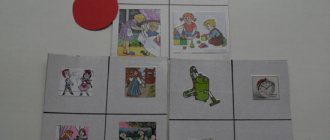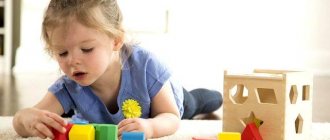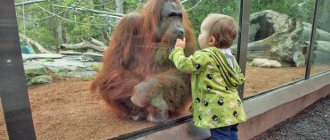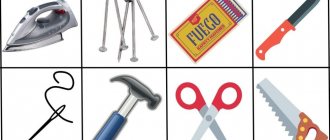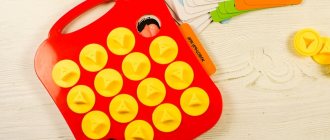Didactic games for experimentation by age (page 1)
Selected and systematized
teacher
(in middle, senior, preparatory groups)
This material can be called didactic games for experimentation or environmental games; they are used both in direct educational and independent activities, at the request of preschoolers, as well as as material for consolidating experiences and experiments.
Cognitive and research activities broaden the child’s horizons and open up space for the development of critical thinking and speech. Conditions are created for active, independent research on a variety of topics and problems.
Preparatory group
"Hide and Seek"
Goal: to deepen knowledge of the properties and qualities of water; develop curiosity; consolidate knowledge of safety rules when handling glass objects.
Material: two jars of water (the first with clear water, the second with tinted water), pebbles, a cloth napkin.
1. Children put a pebble into a jar of clear water and watch it. What's happening? (It is heavy and sank to the bottom.) Why is the pebble visible? (The water is clear).
2. Children drop a pebble into colored water. What is happening? (The pebble is not visible: the water is colored and opaque).
"Sunny bunnies"
Purpose: to introduce the origin of sunbeams, their movement, the objects from which they are reflected; develop ingenuity and curiosity.
Material: mirrors, jar of water, stainless steel plate.
The loose snow is darker in March, the bunny runs around the desk,
The ice on the window is melting. Can't catch him anywhere.
1. Children “catch” a ray of sun with a mirror and direct its reflection in any direction. What's happening? (The mirror will reflect the sun's rays; you can play by changing its tilt).
2. Children take a jar of water and “catch” the sun’s rays (the water reflects them); if you move your hand slightly, the surface of the water begins to move, the “bunnies” begin to jump.
3. The same, with a stainless steel plate.
"Grumpy Ball"
Purpose: to introduce air movement and its properties; develop observation and curiosity.
Materials: bath of water, balloon, cloth napkin.
On holidays on the street they burn and shimmer
The children have balloons in their hands.
1. Children inflate a small balloon, do not tie it. What kind of ball did you get? (large, round, light). Let him go. What happens to the ball? (he begins to “throw around” - this is the air coming out of him).
2. Children inflate the balloon without tying it. Immerse it in the water “neckwise” and gradually unclench your fingers. What will happen? (The air leaves the ball and bubbles appear on the surface of the water).
"Obedient Breeze"
Purpose: to introduce different strengths of air flow and its properties; develop breathing, ingenuity, observation.
Material: water bath, foam boat, cloth napkin.
Wind, wind! You are powerful, you stir the blue sea,
You drive flocks of clouds, you blow everywhere in the open air.
1. Children blow softly on the boat. What's happening? (The ship is sailing slowly.)
2. They do the same with force. (The ship sails faster and may even capsize.)
"Peekaboo"
Purpose: to introduce the properties of water; develop observation, ingenuity, perseverance.
Material: two plexiglass plates, a pipette, glasses with clear and colored water.
One two three four five! Appeared from a pipette,
We'll look for a little bit. Dissolved on the glass.
1. Apply a drop of water from a pipette onto dry glass. Why doesn't it spread? (The dry surface of the plate interferes).
2.Children tilt the plate. What's happening? (The drop flows slowly).
3. Moisten the surface of the plate and drop clear water onto it from a pipette. What's happening? (It will “dissolve” on a damp surface and become invisible).
4. Carefully apply a drop of colored water from a pipette onto the damp surface of the plate. What's happening? (It slowly dissolves in clear water).
"Friends"
Purpose: to introduce the composition of water (oxygen); develop ingenuity, observation, curiosity.
Material: glass of water, bottle of water closed with a stopper, cloth napkin.
1.Place a glass of water in the sun for a few minutes. What's happening? (Bubbles form on the walls of the glass - this is oxygen).
2. Shake the water bottle as hard as you can. What is happening? (A large number of bubbles have formed).
"Hide and Seek"
Goal: to deepen knowledge of the properties and qualities of water; develop curiosity; consolidate knowledge of safety rules when handling glass objects.
Material: two jars of water (the first with clear water, the second with tinted water), pebbles, a cloth napkin.
1. Children put a pebble into a jar of clear water and watch it. What's happening? (It is heavy and sank to the bottom.) Why is the pebble visible? (The water is clear).
2. Children drop a pebble into colored water. What is happening? (The pebble is not visible: the water is colored and opaque).
"Competition"
Purpose: to introduce the condition of the soil; develop observation and curiosity.
Material: two glass jars with soil (one with loose soil, the other with compacted soil), a stick, a cutting of Tradescantia.
1. Children touch the soil in the jars and determine the condition of the soil with a stick. On the advice of the teacher, holes are made. Which soil does the stick penetrate easily, and which with difficulty? Plant cuttings of Tradescantia into holes and water them.
2.The jars are left for several days. Observe: where will the soil dry out faster? Why?
"The Secret of the Pine Cone"
Purpose: to introduce the change in shape of objects under the influence of water; develop observation and ingenuity.
Materials: a bath of warm water, two pine cones, a cloth napkin.
The squirrel picked a cone - She is very bored alone.
But I didn’t find any nuts. Take it and play.
There's a cone lying under the pine tree, and what? Guess for yourself!
1. Children examine the cone, smell it, roll it between their palms, and try to bend the scales. Why don't they bend? (They dried out and became hard.)
2.Dip the cone into warm water. What's happening? (It floats on the surface because it is light) leave the cone in the water for a day.
3.The next day the children look at the bump. She changed form. Why? (It was saturated with water, the plates closed and took on their previous appearance). And she also sank to the bottom. Why? (It became heavy, there was less water in the bath).
"Stubborn Plant"
Purpose: to clarify how light affects the growth of indoor plants; develop observation skills.
Material: indoor plant Kalanchoe (two copies); paper, pencils.
1. Children place one plant on the window. After a few days, they look at what happened to the trunk and leaves (they turned towards the light).
2.The other plant in the pot should be placed on its side and left for three days. What will happen? (The top of the trunk will bend and rise vertically.)
3.Place the Kalanchoe in a dark place for several days. What will happen? (The leaves will begin to wither, fade, the trunk will lose its elasticity - it urgently needs to be exposed to light).
"Dry and wet soil"
Purpose: to introduce the condition of the soil, teach how to identify and compare dry and wet soil, record research results; develop observation and curiosity.
Materials: two glass jars with soil (one with dry soil, the other with wet soil), a magnifying glass, a plexiglass plate, a spatula, a card, pencils.
The soil can be different: podzolic, swampy,
Black, yellow, red, forest gray,
Clayey, sandy, still black earth.
1. How to find out which jar has dry soil and which one has wet soil? (Examine with your fingers; examine with a magnifying glass, compare color, smell.)
Conclusion. Dry soil is crumbly, its lumps are hard. Wet soil is soft and sticky. The fertile layer contains sand, clay, and rotten leaves.
2.What will happen to glass if you cover jars with dry and wet soil with it? The jars are covered with plexiglass plates for 1-2 minutes; traces of moisture evaporation appeared on the plate with which the jar of wet soil was closed, but not on the other plate.
Conclusion. Dry soil does not contain moisture; Evaporation from moist soil occurs into the environment.
3.How is water absorbed into dry and wet soil? Children water dry and wet soil. Bubbles appear on the surface of dry soil: water passes freely between dry lumps, fills dry places and displaces air; There are no air bubbles on the surface of wet soil: soft lumps of soil adhere tightly to each other.
Conclusion. Dry soil cracks, voids appear in it, which are filled with air; water, entering the cracks, pushes it to the surface; the moist soil allows water to pass through unhindered: there were no cracks in it.
"Amazing Sand"
Goal: to introduce the properties and qualities of sand, its origin, to develop ingenuity, observation, and perseverance.
Materials: three glass jars (one with dry sand, the other with wet sand, the third with clear water), a magnifying glass, a plexiglass plate, a spatula, a magnet, a card, pencils.
1.What is sand? What does it consist of? Examine the dry sand with your fingers; pour it onto the plate and examine it with a magnifying glass.
Conclusion. Sand is very small pebbles of different colors, different shapes, different sizes; You can find small particles of metal in the sand.
2.Why does sand sink? Place a handful of dry sand in a jar of water, do not stir it. What's happening? (The sand settles.) Sand dust can be seen on the surface of the water. If you stir water with a spatula, what happens? (Sand dust, when dissolved, colors the water).
Conclusion. Heavy sand - it sinks to the bottom of the jar, light dust - remains on the surface, when stirred, dissolves, colors the water; wet sand changes color.
3.Compare the properties of dry and wet sand. Children are asked to pour dry sand from one jar to another (free-flowing sand); Make a bun from dry sand (it doesn’t work: dry sand is crumbly, rough, contains dust); examine wet sand (dense, soft) through a magnifying glass, make rings out of it, leave them for a while (the sand will dry); water dry and wet sand (wet sand quickly allows moisture to pass through, while dry sand holds it on the surface for some time, then it goes deeper).
Conclusion. Sand allows water to pass through well; You can sculpt objects from wet sand, but dry sand does not hold its shape.
| Due to its large volume, this material is placed on several pages: 1 |
Get text
Who lives in the water
Target:
develop cognitive interest and imagination.
You will need blue and cyan pencils or watercolors, a landscape sheet
Water men
We spent the whole day splashing in the river. And then they climbed into the basin for another swim.
Sandmen live in the sandbox, and water men live in the water (in the sea, in the lake, in the river, as well as in the bathtub and basin). The water men are also very fun to play with. They may look like the picture. But you can come up with water men yourself and draw them in an album. Give your child blue and cyan crayons or watercolors and ask him to draw his own water people.
Drawing artists
Target:
make you want to draw on a wet sheet, find out that the colors are mixed and do not have a clear boundary, new colors are obtained. You will need a large sheet of watercolor paper moistened with water, oilcloth, paints and brushes.
The sun is yellow in the sky
Red flowers bloom
A fish splashes in the blue sea. Draw it all.
The process of painting with watercolors on a wet sheet can give you an unforgettable experience. To do this, lay an oilcloth on the table and wet a thick sheet of watercolor paper. Dip your brush into one of the paints and gently brush over the paper. Ask the children what will happen if we use other colors. Give the opportunity to play with colors. As if by chance, you can brush over the drawing with just water, without paint - the water will create delicate, blurry, light halftones on the sheet.
Drink delicious juice dolls
Target:
identify the properties of water and paints, the ability of paints to dissolve in water and change its color.
You will need watercolor paints, brushes, and clear plastic glasses with water.
One day the bunny decided to show his mother a trick. He placed transparent glasses on the table. Then he poured water into them. Water flowed gurgle-glug.
- Mom, close your eyes! - said Bunny.
Mom closed her eyes and began to wait for what would happen. (And you close your eyes).
- Open up! - Bunny commanded.
When mom opened her eyes, she saw that the water in the glasses was no longer plain, but multi-colored - yellow, red, blue, green and orange. (And you show with your finger which one is which). - How beautiful! - Mom was delighted.
Invite the children to prepare multi-colored juice for the dolls, try to attract the child’s attention with an element of magic: “And if we put a brush with yellow paint in a glass of water, I wonder what will happen. What kind of juice is this? »
Set the table, arrange the glasses, seat the dolls, and treat them to drinks. Red water will turn into tomato juice, orange water into orange juice, yellow water into pineapple juice, and blue water into blackberry juice.
Soap bubbles
Target:
create a desire to blow soap bubbles, introduce the fact that when air gets into soapy water, a bubble forms.
Material:
soapy water, cocktail straws, bottles with the bottom cut off, helium pen body.
Progress of the game - experiment
Artistic word
Vodichka doesn’t like slobs and dirty people,
Seething and swearing: “Glug-bul-bul-bul! “But if we wash our hands and faces, Vodichka is happy and is no longer angry.
Lather your hands until you get a lush, thick foam. Then separate your palms so that a thin transparent soap film forms between them. Blow on it and you will get a soap bubble. Let the child blow on the soap film in your palms, help him make his own soap bubble. To encourage your child to blow soap bubbles on his own, offer him, in addition to a frame from a purchased bubble, a variety of tubes - a cocktail tube, a plastic bottle with the bottom cut off, or roll and glue a thick tube from thick paper. To get a solid tube (kids often bite or bend cocktail tubes), you can disassemble the helium pen and take the body from it - a transparent plastic tube.
You can make your own bubble water using dishwashing liquid.
How the water went for a walk
Target:
give an idea that water can be collected with various objects - a sponge, a pipette, a bulb, a napkin.
You will need a foam sponge, a plastic syringe without a needle, a rubber bulb, and a bath of water.
They poured some water into the basin and forgot about it. After a while, the water girl got bored: “I’m sitting here and I don’t see anything, but there are probably so many interesting things around!” “She wanted to get out of the basin, but it didn’t work - the water doesn’t have arms or legs. She wanted to call someone, but the voice of the water in the basin was quiet - no one heard her. And then my mother came and thought: “Why is there water standing here? "Took it and poured it into the sink. Water flowed through the pipes and ended up in a large river, in which there was a lot of other water. And our water flowed along with the big river through the city, past beautiful houses and green gardens. “How beautiful, how wonderful! - thought the water girl. “If I were sitting in my basin and wouldn’t see this beauty!” »
Take a foam or other absorbent sponge, a rubber bulb and a plastic syringe (without a needle). Pour water into a small basin, prepare several empty containers (cups, bowls, etc.). Ask your child to dip the sponge in water and show how to squeeze it into the cup. Then take the water with a rubber bulb and pour it into another container. Do the same with the syringe.
A piece of ice is melting
Target:
introduce what freezes in the cold and melts in the warmth.
You will need a candle, spoon, ice, transparent glasses with hot and cold water.
One winter, a little squirrel brought home a piece of ice, an icicle, he left it in a hollow, on the floor in the hallway, and he went to have dinner and then sleep. When I woke up, I immediately remembered about the piece of ice and ran into the hallway. The piece of ice was gone - nowhere to be found, but there was a glistening puddle on the floor.
Put a piece of ice on a spoon and heat it over the candle flame: “Look, here is ice. Let's heat it up on the fire. Where is the ice? Melted! What did the ice turn into? In the water! »
Pour hot water into a transparent glass mug or glass (it can be tinted, put in a piece of ice and watch how quickly it melts. You can take several glasses and watch how ice melts differently in water of different temperatures.

